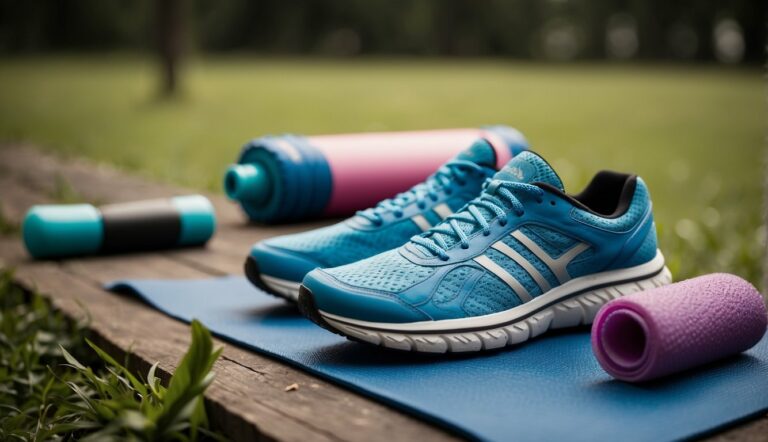Asthma-Friendly Running Warm-Up (Quick 10-Minute Routine)
When incorporating running into your lifestyle with asthma, a proper warm-up is essential to manage your symptoms and safeguard your lungs.
Engaging in a 10-minute warm-up routine can help prevent the onset of wheezing, coughing, or shortness of breath—common exercise-induced symptoms for asthmatics. This pre-exercise preparation gently prepares your respiratory system for the increased demand that exercise places on it.
Your warm-up should be a tailored blend of light aerobic activity and dynamic stretching. Starting with a gentle pace gradually signals your lungs to adjust to the impending physical exertion. Incorporating controlled bursts of intensity can further acclimate your respiratory pathways, reducing the likelihood of triggering asthma symptoms.
By adhering to a strategic warm-up regimen, you can make your runs more enjoyable and less daunting. This approach doesn’t just prep your muscles and joints, but significantly, it ensures your lungs are better equipped to handle the workout, helping to maintain an asthma-friendly exercise routine that supports lung function and overall health.
The Best Warm-Up Routine for Runners with Asthma
Before you lace up your running shoes, a targeted warm-up designed specifically for asthma can help minimize the risk of flare-ups and maximize your running performance.
Designing an Asthma-Friendly Warm-Up Routine
A 10-minute warm-up routine for runners with asthma should be designed to gradually increase heart rate and blood flow to the muscles while also preparing the respiratory system for the increased demand of exercise.
Here’s a step-by-step guide with specific exercises:
- Begin with a Brisk Walk (2 minutes): Start your warm-up with a brisk walk to ease your body into exercise mode. Keep a pace that elevates your heart rate slightly but allows you to breathe comfortably.
- Transition to a Gentle Jog (3 minutes): After walking, transition into a gentle jog. This should be at a low intensity, just a notch above your brisk walk. The aim is to slowly increase your heart rate and respiratory rate without causing strain.
- Dynamic Stretching (2 minutes):
- Leg Swings (1 minute): Stand on one leg and swing the other leg forward and back, then side to side. Perform 30 seconds per leg.
- Arm Circles (30 seconds): Extend your arms out to the sides and make small circles, gradually increasing to larger circles for 15 seconds, then reverse the direction for another 15 seconds.
- Lunges with a Twist (30 seconds): Step forward into a lunge and add an upper body twist towards the leg that is in front. Alternate legs and twist for 30 seconds.
- Breathing Drills (1 minute):
- Pursed-Lip Breathing (30 seconds): Inhale through your nose for a couple of seconds and exhale slowly through pursed lips.
- Diaphragmatic Breathing (30 seconds): Place one hand on your belly and the other on your chest. Inhale deeply through your nose, feeling your belly rise, and exhale slowly.
- Gradual Build-Up Run (2 minutes): Increase the intensity of your jog, building up to a pace that is close to your desired training intensity. This should be done gradually to avoid triggering asthma symptoms.
Throughout this warm-up routine, it’s essential to stay mindful of your breathing and to stop if you feel any discomfort or asthma symptoms.
Always have your quick-relief inhaler readily available, and use it 10-15 minutes before starting your warm-up if that is part of your prescribed asthma management plan (AAFA). Remember to consult with your healthcare provider before beginning any new exercise routine to ensure it’s safe for your specific asthma condition.
Breathing Exercises and Techniques
Proper breathing exercises are crucial for managing asthma during your run.
- Diaphragmatic Breathing:
- Sit comfortably or stand with good posture.
- Place one hand on your belly, and the other on your chest.
- Breathe in slowly through your nose, feeling your stomach expand, while your chest remains relatively still.
- Exhale slowly through pursed lips.
- Paced Breathing:
- Inhale for a count of two.
- Exhale for a count of four, which should help with any tightness or constriction.
Rehearsing these breathing techniques during your warm-up establishes a pattern that can help maintain optimal breathing throughout your run.
Asthma and Running – What is the Impact?
Running is a form of physical activity that can affect your asthma. Understanding how exercise influences your symptoms and recognizing your triggers are key for maintaining lung health while reaping the exercise benefits.
Recognizing Asthma Symptoms and Triggers
When you engage in physical activity, you may experience exercise-induced asthma, which can manifest as shortness of breath, wheezing, or tightness in the chest. It’s vital to identify your specific asthma triggers, commonly including allergens, cold air, or pollution, to prevent an asthma attack during exercise.
Common Symptoms:
- Wheezing
- Shortness of breath
- Chest tightness
Frequent Triggers:
- Allergens (pollen, dust)
- Cold, dry air
- Air pollution
Exploring Benefits of Exercise for Asthma
Contrary to what you may think, regular exercise can benefit your asthma by improving lung function and reducing inflammation in your airways. While lung capacity is largely determined by body size, ensuring controlled breathing during exercise can help prevent the narrowing of air passages and improve your overall lung health.
Benefits of Exercise:
- Strengthens lungs
- Reduces inflammation
Tips for Exercise:
- Warm up properly
- Use prescribed inhalers as directed
- Monitor the environment for triggers
Running with Asthma in Different Environments

When you have asthma, running in various environments requires awareness and preparation to manage symptoms effectively.
Adjusting for Pollen and Pollution
Running outdoors can expose you to pollen and pollution—two triggers that may exacerbate asthma symptoms. To minimize your exposure to these triggers:
- Check daily pollen counts: Use weather apps or websites to stay informed about the pollen levels in your area. Opt for a run when counts are lower, usually in the early morning or late evening.
- Identify clean air routes: Select running paths away from heavy traffic to reduce exposure to air pollution. Parks and trails can be good options.
Tips for Avoiding Pollen and Pollution
| Strategy | Tips |
|---|---|
| Monitor Pollen Counts | Always check local pollen levels before heading out and plan runs accordingly. |
| Choose Cleaner Routes | Run in areas with lower traffic to avoid pollution and consider indoor running on high pollen or pollution days. |
| Wear a mask or scarf | If running when pollution or pollen is unavoidable, wearing a mask or scarf can help filter out some particulates. |
Strategies for Cold Weather Running
Cold air can be particularly challenging for asthma as it may trigger symptoms like wheezing or shortness of breath. Here’s how to run safely in colder climates:
- Warm up indoors: Spend at least 10 minutes getting your muscles ready in a warm environment before venturing outside. This can help acclimate your body to the temperature change.
- Cover your nose and mouth: Wearing a mask or scarf over your nose and mouth helps to warm and humidify the air you breathe, which can reduce the likelihood of an asthma flare-up.
Cold Weather Running Strategy
| Consideration | Action |
|---|---|
| Indoor Warm-Up | Prepare your body with an indoor warm-up to lessen the shock of cold air on your respiratory system. |
| Protection from Cold Air | A scarf or a mask can help warm the air before it enters your lungs, reducing asthma symptoms. |
Make sure to dress in layers that you can remove as you warm up to maintain body temperature without overheating. Managing asthma while running requires adaptation to your environment—being prepared makes all the difference.
Post-Run Cool Down and Recovery
After your run, entering into a cool-down phase allows your body to gradually transition back to a resting state. It’s important for assisting in recovery and maintaining a healthy lifestyle.
Steps for Effective Cool-Down:
- Lower Intensity: Begin with 5-10 minutes of low-intensity jogging or walking to reduce your heart rate.
- Hydration: Drink water to rehydrate and aid recovery.
- Stretching: Spend 5 minutes on dynamic stretches to help prevent stiffness and improve flexibility.
Stretching Routine Post-Run
Key Stretches (Hold each for 15-30 seconds):
- Quadriceps Stretch: Stand on one foot, pull the other heel to your buttock, hold, and switch.
- Hamstring Stretch: Place your foot on an elevated surface and lean forward gently from your hips.
- Calf Stretch: Stand facing a wall with one foot behind the other and gently press the back heel down.
Tip: Breathe deeply and never force a stretch to the point of pain.
Why Cool Down Matters: Cooling down helps in reducing muscle soreness and prepares your muscles for your next workout. Your fitness levels will gradually improve as your body learns to recover more efficiently, which is a fundamental aspect of a healthy lifestyle.
Remember: Tailor your cool-down to your run’s intensity; the more intense the run, the longer your body needs to recover. Your personal fitness levels should guide your recovery process.






